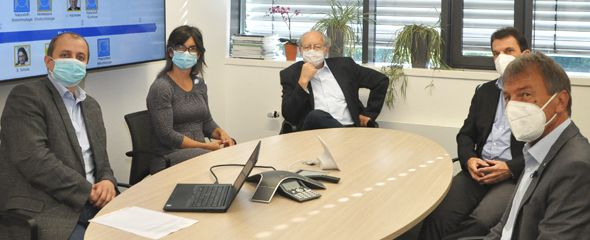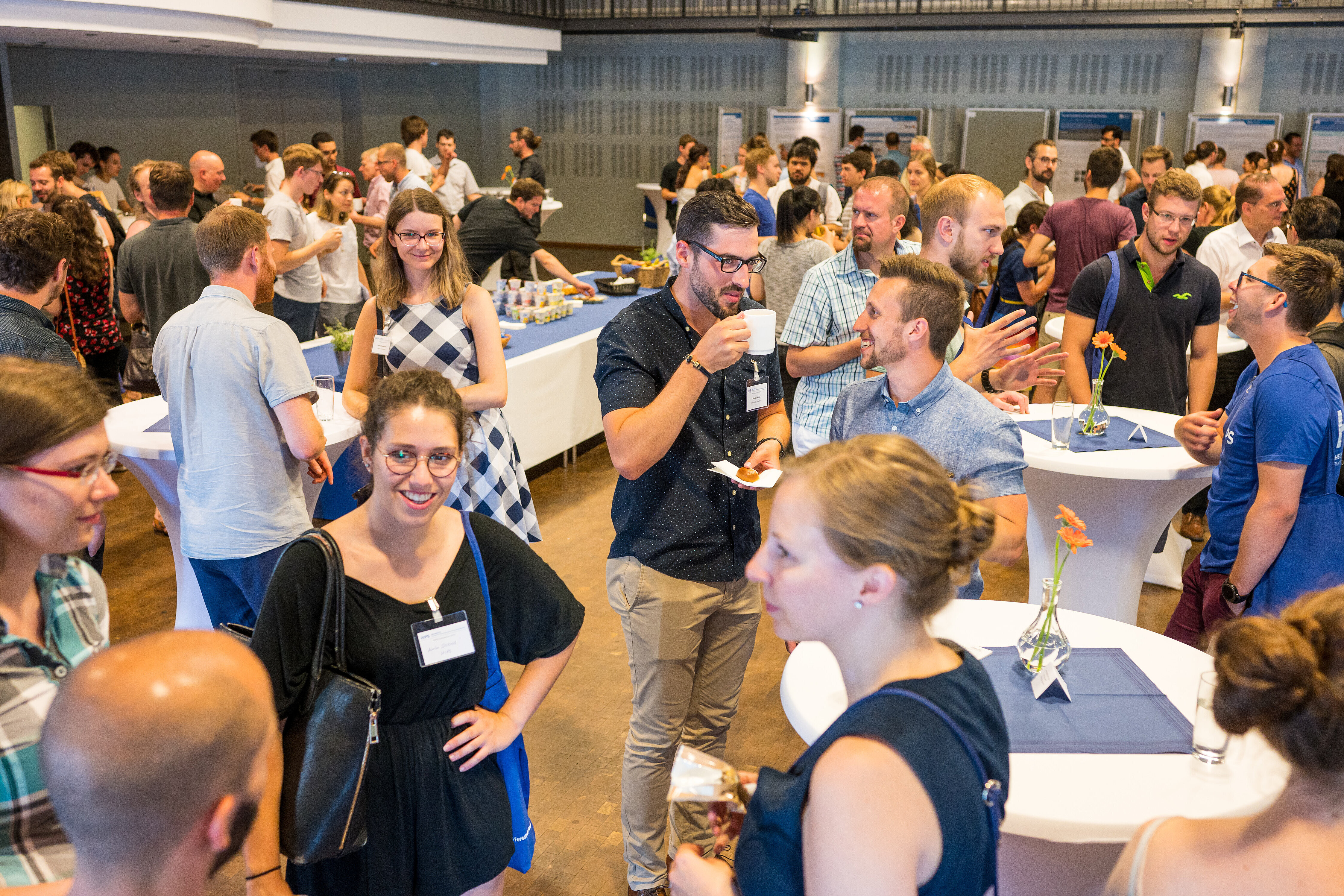Author count: 12
Tistechok S., Bratiichuk D., Sucipto H., Gummerlich N., Stierhof M., Gromyko O., Fries F., Fedorenko V., Müller R., Zapp J., ... , Myronovskyi M., Luzhetskyy A.
(2025)
Gromomycins: An Unprecedented Class of Triterpene Antibiotics Produced by a Novel Biosynthetic Pathway
Angew.Chem.Int.Ed Engl.
Author count: 2
Bilyk O., Luzhetskyy A.
(2016)
Host Organism: Streptomyces
(13)
Author count: 8
Melnyk S., Stierhof M., Bratiichuk D., Fries F., M++ller R., Rebets Y., ... , Luzhetskyy A., Ostash B.
(2025)
Uncovering the genetic basis of antiviral polyketide limocrocin biosynthesis through heterologous expression
Microb Cell Fact,
24
(1)
Author count: 9
Eckert N., Rebets Y., Horbal L., Zapp J., Herrmann J., Busche T., Müller R., ... , Kalinowski J., Luzhetskyy A.
(2023)
Discovery and overproduction of novel highly bioactive pamamycins through transcriptional engineering of the biosynthetic gene cluster
Microb.Cell Fact.,
22
(1)
Author count: 4
Stierhof M., Myronovskyi M., Zapp J., Luzhetskyy A.
(2023)
Heterologous Production and Biosynthesis of Threonine-16:0dioic acids with a Hydroxamate Moiety
J.Nat.Prod.
Author count: 7
Lopatniuk M., Riedel F., Wildfeuer J., Stierhof M., Dahlem C., ... , Kiemer A.K., Luzhetskyy A.
(2023)
Development of a Streptomyces-based system for facile thioholgamide library generation and analysis
Metab Eng,
78
(July 2023,)
Author count: 5
Tistechok S., Roman I., Fedorenko V., Luzhetskyy A., Gromyko O.
(2023)
Diversity and bioactive potential of Actinomycetia from the rhizosphere soil of Juniperus excelsa
Folia Microbiol.
Author count: 6
Tistechok S., Stierhof M., Kachor A., Myronovskyi M., Gromyko O., Luzhetskyy A.
(2022)
Flavacol and Its Novel Derivative 3-b[beta]-Hydroxy Flavacol from Streptomyces sp. Pv 4-95 after the Expression of Heterologous AdpA
Microorg.,
10
(12)
Author count: 10
Tseduliak V.M., Dolia B., Ostash I., Lopatniuk M., Busche T., Ochi K., Kalinowski J., Luzhetskyy A., ... , Fedorenko V., Ostash B.
(2023)
Mutations within gene XNR_2147 for TetR-like protein enhance lincomycin resistance and endogenous specialized metabolism of Streptomyces albus J1074
J.Appl.Genet.
Author count: 6
Tistechok S., Stierhof M., Myronovskyi M., Zapp J., Gromyko O., Luzhetskyy A.
(2022)
Furaquinocins K and L: Novel Naphthoquinone-Based Meroterpenoids from Streptomyces sp. Je 1-369
Antibiotics,
11
(11)
Author count: 5
Rebets Y., Kormanec J., Lutzhetskyy A., Bernaerts K., Anne J.
(2022)
Cloning and Expression of Metagenomic DNA in Streptomyces lividans and Its Subsequent Fermentation for Optimized Production
Methods Mol Biol,
2555
(16)
Author count: 8
Paulus C., Myronovskyi M., Zapp J., Rodríguez Estévez M., Lopatniuk M., Rosenkränzer B., ... , Palusczak A., Luzhetskyy A.
(2022)
Miramides A-D: Identification of Detoxin-like Depsipeptides after Heterologous Expression of a Hybrid NRPS-PKS Gene Cluster from Streptomyces mirabilis Lu17588
Microorganisms.,
10
(9)
Author count: 5
Tistechok S., Myronovskyi M., Fedorenko V., Luzhetskyy A., Gromyko O.
(2022)
Screening of Thiopeptide-Producing Streptomycetes Isolated From the Rhizosphere Soil of Juniperus excelsa
Curr.Microbiol.,
79
(10)
Author count: 6
Tistechok S.I., Tymchuk I.V., Korniychuk O.P., Fedorenko V.O., Luzhetskyy A.M., Gromyko O.M.
(2021)
Genetic Identification and Antimicrobial Activity of Streptomyces sp. Strain Je 1-6 Isolated from Rhizosphere Soil of Juniperus excelsa Bieb
Cytol.Genet.,
55
(1)
Author count: 8
Shuai H., Myronovskyi M., Rosenkränzer B., Paulus C., Nadmid S., Stierhof M., ... , Kolling D., Luzhetskyy A.
(2021)
Novel Biosynthetic Route to the Isoquinoline Scaffold
ACS Chem.Biol.,
17
(3)
Author count: 3
Paulus C., Gromyko O., Luzhetskyy A.
(2021)
New kendomycin derivative isolated from streptomyces sp. Cl 58-27
Molecules,
26
(22)
Author count: 5
Kolling D., Stierhof M., Lasch C., Myronovskyi M., Luzhetskyy A.
(2021)
A promiscuous halogenase for the derivatization of flavonoids
Molecules,
26
(20)
Author count: 3
Paulus C., Zapp J., Luzhetskyy A.
(2021)
New scabimycins A-C isolated from streptomyces acidiscabies (Lu19992)
Molecules,
26
(19)
Author count: 54
Miethke M., Pieroni M., Weber T., Brönstrup M., Hammann P., Halby L., Arimondo P.B., Glaser P., Aigle B., Bode H.B., Moreira R., Li Y., Luzhetskyy A., Medema M.H., Pernodet J.L., Stadler M., Tormo J.R., Genilloud O., Truman A.W., Weissman K.J., Takano E., Sabatini S., Stegmann E., Brötz-Oesterhelt H., Wohlleben W., Seemann M., Empting M., Hirsch A.K.H., Loretz B., Lehr C.M., Titz A., Herrmann J., Jaeger T., Alt S., Hesterkamp T., Winterhalter M., Schiefer A., Pfarr K., Hoerauf A., Graz H., Graz M., Lindvall M., Ramurthy S., Karlen A., van Dongen M., Petkovic H., Keller A., Peyrane F., Donadio S., Fraisse L., Piddock L.J.V., Gilbert I.H., ... , Moser H.E., Müller R.
(2021)
Towards the sustainable discovery and development of new antibiotics
Nat.Rev.Chem.
Author count: 7
Tistechok S., Skvortsova M., Mytsyk Y., Fedorenko V., Parnikoza I., ... , Luzhetskyy A., Gromyko O.
(2021)
The diversity and antibacterial activity of culturable actinobacteria isolated from the rhizosphere soil of Deschampsia antarctica (Galindez Island, Maritime Antarctic)
Polar Biol.,
44
(9)
Author count: 6
Horbal L., Stierhof M., Palusczak A., Eckert N., Zapp J., Luzhetskyy A.
(2021)
Cyclofaulknamycin with the rare amino acid d-capreomycidine isolated from a well-characterized streptomyces albus strain
Microorg.,
9
(8)
Author count: 6
Lasch C., Stierhof M., Estevez M.R., Myronovskyi M., Zapp J., Luzhetskyy A.
(2021)
Bonsecamin: A new cyclic pentapeptide discovered through heterologous expression of a cryptic gene cluster
Microorg.,
9
(8)
Author count: 8
Axenov-Gribanov D.V., Morgunova M.M., Vasilieva U.A., Gamaiunov S.V., Dmitrieva Krasnova, Pereliaeva E.V., ... , Belyshenko A.Y., Luzhetskyy A.N.
(2021)
Composition of nutrient media and temperature of cultivation imposes effect on the content of secondary metabolites of Nocardiopsis sp. isolated from a Siberian Cave
3 Biotech,
11
(8)
Author count: 7
Axenov-Gribanov D.V., Rzhechitskiy Y.A., Morgunova M.M., Emshanova V.A., Lubyaga Y.A., ... , Vereshchagina K.P., Luzhetskyy A.N.
(2021)
High concentrations of dissolved oxygen influence the composition of low molecular weight natural compounds in Lake Baikal endemic amphipods
Crustaceana,
94
(4)
Author count: 4
Stierhof M., Myronovskyi M., Zapp J., Luzhetskyy A.
(2021)
Discovery and heterologous production of new cyclic depsibosamycins
Microorg.,
9
(7)
Author count: 8
Gummerlich N., Manderscheid N., Rebets Y., Myronovskyi M., Glaser L., Kuhl M., ... , Wittmann C., Luzhetskyy A.
(2021)
Engineering the precursor pool to modulate the production of pamamycins in the heterologous host S. albus J1074
Metab.Eng.,
67
(September 2021)
Author count: 11
Koshla O., Lopatniuk M., Borys O., Misaki Y., Kravets V., Ostash I., Shemediuk A., Ochi K., Luzhetskyy A., ... , Fedorenko V., Ostash B.
(2021)
Genetically engineered rpsL merodiploidy impacts secondary metabolism and antibiotic resistance in Streptomyces
World J.Microbiol.Biotechnol.,
37
(4)
Author count: 14
Pikl S., Rincón A.F.C., Slemc L., Goranovic D., Avbelj M., Gjuracic K., Sucipto H., Stare K., Baebler S., Sala M., Guo M., Luzhetskyy A., ... , Petkovic H., Magdevska V.
(2021)
Multiple copies of the oxytetracycline gene cluster in selected Streptomyces rimosus strains can provide significantly increased titers
Microb.Cell Fact.,
20
(1)
Author count: 5
Gummerlich N., Rebets Y., Paulus C., Zapp J., Luzhetskyy A.
(2020)
Targeted genome mining-from compound discovery to biosynthetic pathway elucidation
Microorg.,
8
(12)
Author count: 6
Lasch C., Stierhof M., Estevez M.R., Myronovskyi M., Zapp J., Luzhetskyy A.
(2020)
Dudomycins: New Secondary Metabolites Produced After Heterologous Expression of an Nrps Cluster from Streptomyces albus ssp. Chlorinus Nrrl B-24108
Microorganisms.,
8
(11)
Author count: 7
Shtenikov M.D., Ostapchuk A.M., Vasylieva N.Y., Luzhetskyy A.M., Rückert C., ... , Kalinowski J., Ivanytsia V.
(2020)
Characteristics of genome of bacillus velezensis onu 553 strain isolated from the bottom sediments of the black sea
Mikrobiol Z,
82
(3)
Author count: 6
Lasch C., Gummerlich N., Myronovskyi M., Palusczak A., Zapp J., Luzhetskyy A.
(2020)
Loseolamycins: A group of new bioactive alkylresorcinols produced after heterologous expression of a type III PKS from micromonospora endolithica
Molecules,
25
(20)
Author count: 4
Sikandar A., Lopatniuk M., Luzhetskyy A., Koehnke J.
(2020)
Non-Heme Monooxygenase ThoJ Catalyzes Thioholgamide b[beta]-Hydroxylation
ACS Chem Biol,
15
(10)
Author count: 3
Marques F., Luzhetskyy A., Mendes M.V.
(2020)
Engineering Corynebacterium glutamicum with a comprehensive genomic library and phage-based vectors
Metab.Eng.,
62
(Nov.)
Author count: 9
Erdenetsogt U., Nadmid S., Paulus C., Chanagsuren G., Dolgor E., Gotov C., Dahse H.M., ... , Luzhetskyy A., Dagvadorj E.
(2020)
Bioactive flavonoids from plant extract of Pyrethrum pulchrum and its acute toxicity
Nat.Prod.Res.
Author count: 9
Sikandar A., Franz L., Adam S., Santos-Aberturas J., Horbal L., Luzhetskyy A., Truman A.W., ... , Kalinina O.V., Koehnke J.
(2020)
Author Correction: The bottromycin epimerase BotH defines a group of atypical a[alpha]/b[beta]-hydrolase-fold enzymes (Nature Chemical Biology, (2020), 10.1038/s41589-020-0569-y)
Nat.Chem.Biol.,
16
(9)
Author count: 4
Shuai H., Myronovskyi M., Nadmid S., Luzhetskyy A.
(2020)
Identification of a Biosynthetic Gene Cluster Responsible for the Production of a New Pyrrolopyrimidine Natural Product-Huimycin
Biomolecules,
10
(7)
Author count: 9
Sikandar A., Franz L., Adam S., Santos-Aberturas J., Horbal L., Luzhetskyy A., Truman A.W., ... , Kalinina O.V., Koehnke J.
(2020)
The bottromycin epimerase BotH defines a group of atypical a[alpha]/b[beta]-hydrolase-fold enzymes
Nat.Chem.Biol.,
16
(9)
Author count: 7
Estevez M.R., Myronovskyi M., Rosenkränzer B., Paululat T., Petzke L., ... , Ristau J., Luzhetskyy A.
(2020)
Novel Fredericamycin Variant Overproduced by a Streptomycin-resistant Streptomycesalbus subsp. chlorinus Strain
Mar.Drugs,
18
(6)
Author count: 12
Dahlem C., Siow W.X., Lopatniuk M., Tse W.K.F., Kessler S.M., Kirsch S.H., Hoppstädter J., Vollmar A.M., Müller R., Luzhetskyy A., ... , Bartel K., Kiemer A.K.
(2020)
Thioholgamide A, a new anti-proliferative anti-tumor agent, modulates macrophage polarization and metabolism
Cancers.(Basel),
12
(5)
Author count: 12
Voitsekhovskaia I., Paulus C., Dahlem C., Rebets Y., Nadmid S., Zapp J., Axenov-Gribanov D., Rückert C., Timofeyev M., Kalinowski J., ... , Kiemer A.K., Luzhetskyy A.
(2020)
Baikalomycins A-C, new aquayamycin-type angucyclines isolated from lake baikal derived streptomyces sp. IB201691-2A
Microorganisms.,
8
(5)
Author count: 6
Myronovskyi M., Rosenkränzer B., Stierhof M., Petzke L., Seiser T., Luzhetskyy A.
(2020)
Identification and Heterologous Expression of the Albucidin Gene Cluster from the Marine Strain Streptomyces Albus Subsp. Chlorinus NRRL B-24108
Microorganisms.,
8
(2)
Author count: 5
Estevez M.R., Gummerlich N., Myronovskyi M., Zapp J., Luzhetskyy A.
(2020)
Benzanthric Acid, a Novel Metabolite From Streptomyces albus Del14 Expressing the Nybomycin Gene Cluster
Front.Chem.,
7
Author count: 6
Ahmed Y., Rebets Y., Estevez M.R., Zapp J., Myronovskyi M., Luzhetskyy A.
(2020)
Engineering of Streptomyces lividans for heterologous expression of secondary metabolite gene clusters
Microb.Cell Fact.,
19
(1)
Author count: 2
Myronovskyi M., Luzhetskyy A.
(2019)
Heterologous production of small molecules in the optimized Streptomyces hosts
Nat.Prod.Rep.,
36
(9)
Author count: 12
Rebets Y., Nadmid S., Paulus C., Dahlem C., Herrmann J., Hübner H., Rückert C., Kiemer A.K., Gmeiner P., Kalinowski J., ... , Müller R., Luzhetskyy A.
(2019)
Perquinolines A-C: Unprecedented Bacterial Tetrahydroisoquinolines Involving an Intriguing Biosynthesis
Angew.Chem.Int.Ed.,
58
(37)
Author count: 8
Lopatniuk M., Myronovskyi M., Nottebrock A., Busche T., Kalinowski J., Ostash B., ... , Fedorenko V., Luzhetskyy A.
(2019)
Effect of "ribosome engineering" on the transcription level and production of S. albus indigenous secondary metabolites
Appl.Microbiol.Biotechnol.,
103
(17)
Author count: 7
Yushchuk O., Horbal L., Ostash B., Marinelli F., Wohlleben W., ... , Stegmann E., Fedorenko V.
(2019)
Regulation of teicoplanin biosynthesis: refining the roles of tei cluster-situated regulatory genes
Appl.Microbiol Biotechnol.,
103
(10)
Author count: 11
Koshla O., Yushchuk O., Ostash I., Dacyuk Y., Myronovskyi M., Jäger G., Süssmuth R.D., Luzhetskyy A., Bystrom A., ... , Kirsebom L.A., Ostash B.
(2019)
Gene miaA for post-transcriptional modification of tRNAXXA is important for morphological and metabolic differentiation in Streptomyces
Mol.Microbiol,
112
(1)
Author count: 5
Kuzhyk Y., Lopatniuk M., Luzhetskyy A., Fedorenko V., Ostash B.
(2019)
Genome Engineering Approaches to Improve Nosokomycin A Production by Streptomyces ghanaensis B38.3
Indian Journal of Microbiology,
59
(1)
Author count: 12
Hamed M.B., Vrancken K., Bilyk B., Koepff J., Novakova R., Van Mellaert L., Oldiges M., Luzhetskyy A., Kormanec J., Anne J., ... , Karamanou S., Economou A.
(2018)
Monitoring protein secretion in Streptomyces using fluorescent proteins
Front.Microbiol.,
9
(DEC)
Author count: 20
Rebets Y., Tsolis K.C., Guðmundsdóttir E.E., Koepff J., Wawiernia B., Busche T., Bleidt A., Horbal L., Myronovskyi M., Ahmed Y., Wiechert W., Rückert C., Hamed M.B., Bilyk B., Anne J., Fridjonsson O., Kalinowski J., Oldiges M., ... , Economou A., Luzhetskyy A.
(2018)
Characterization of sigma factor genes in streptomyces lividans TK24 using a genomic library-based approach for multiple gene deletions
Front.Microbiol.,
9
(DEC)
Author count: 5
Estevez M.R., Myronovskyi M., Gummerlich N., Nadmid S., Luzhetskyy A.
(2018)
Heterologous expression of the nybomycin gene cluster from the marine strain streptomyces albus subsp. chlorinus NRRL B-24108
Mar.Drugs,
16
(11)
Author count: 6
Myronovskyi M., Rosenkränzer B., Nadmid S., Pujic P., Normand P., Luzhetskyy A.
(2018)
Generation of a cluster-free Streptomyces albus chassis strains for improved heterologous expression of secondary metabolite clusters
Metab.Eng.,
49
(Sept)
Author count: 5
Horbal L., Marques F., Nadmid S., Mendes M.V., Luzhetskyy A.
(2018)
Secondary metabolites overproduction through transcriptional gene cluster refactoring
Metab Eng,
49
Author count: 8
Yushchuk O., Ostash I., Vlasiuk I., Gren T., Luzhetskyy A., Kalinowski J., ... , Fedorenko V., Ostash B.
(2018)
Heterologous AdpA transcription factors enhance landomycin production in Streptomyces cyanogenus S136 under a broad range of growth conditions
Appl.Microbiol.Biotechnol.,
102
(19)
Author count: 6
Paulus C., Rebets Y., Zapp J., Rückert C., Kalinowski J., Luzhetskyy A.
(2018)
New alpiniamides from Streptomyces sp. IB2014/011-12 assembled by an unusual hybrid non-ribosomal peptide synthetase trans-AT polyketide synthase enzyme
Front.Microbiol.,
9
(AUG)
Author count: 16
Busche T., Tsolis K.C., Koepff J., Rebets Y., Rückert C., Hamed M.B., Bleidt A., Wiechert W., Lopatniuk M., Yousra A., Anne J., Karamanou S., Oldiges M., Kalinowski J., ... , Luzhetskyy A., Economou A.
(2018)
Multi-omics and targeted approaches to determine the role of cellular proteases in streptomyces protein secretion
Front.Microbiol.,
9
(JUN)
Author count: 7
Rebets Y., Schmelz S., Gromyko O., Tistechok S., Petzke L., ... , Scrima A., Luzhetskyy A.
(2018)
Design, development and application of whole-cell based antibiotic-specific biosensor
Metab.Eng.,
47
(May)
Author count: 2
Lilya H., Andriy L.
(2017)
The genetic system of actinobacteria
(5)
Author count: 3
Horbal L., Siegl T., Luzhetskyy A.
(2018)
A set of synthetic versatile genetic control elements for the efficient expression of genes in Actinobacteria
Sci.Rep.,
8
(1)
Author count: 3
Lopatniuk M., Myronovskyi M., Luzhetskyy A.
(2017)
Streptomyces albus: A New Cell Factory for Non-Canonical Amino Acids Incorporation into Ribosomally Synthesized Natural Products
ACS Chem.Biol.,
12
(9)
Author count: 5
Ahmed Y., Rebets Y., Tokovenko B., Br÷tz E., Luzhetskyy A.
(2017)
Identification of butenolide regulatory system controlling secondary metabolism in Streptomyces albus J1074
Sci.Rep.,
7
(1)
Author count: 8
Protasov E.S., Axenov-Gribanov D.V., Rebets Y.V., Voytsekhovskaya I.V., Tokovenko B.T., Shatilina Z.M., ... , Luzhetskyy A.N., Timofeyev M.A.
(2017)
The diversity and antibiotic properties of actinobacteria associated with endemic deepwater amphipods of Lake Baikal
Antonie Van Leeuwenhoek Int.J.Gen.Mol.Microbiol.,
110
(12)
Author count: 5
Rebets Y., Kormanec J., Lutzhetskyy A., Bernaerts K., Anne J.
(2017)
Cloning and expression of metagenomic dna in streptomyces lividans and subsequent fermentation for optimized production
Author count: 8
Koshla O., Lopatniuk M., Rokytskyy I., Yushchuk O., Dacyuk Y., Fedorenko V., ... , Luzhetskyy A., Ostash B.
(2017)
Properties of Streptomyces albus J1074 mutant deficient in tRNALeu UAA gene bldA
Arch.Microbiol.,
199
(8)
Author count: 11
Sun Y.Q., Busche T., Rückert C., Paulus C., Rebets Y., Novakova R., Kalinowski J., Luzhetskyy A., Kormanec J., ... , Sekurova O.N., Zotchev S.B.
(2017)
Development of a Biosensor Concept to Detect the Production of Cluster-Specific Secondary Metabolites
ACS Synth.Biol.,
6
(6)
Author count: 8
Tokovenko B., Ruckert C., Kalinowski J., Mohammadipanah F., Wink J., Rosenkranzer B., ... , Myronovskyi M., Luzhetskyy A.
(2017)
Complete Draft Genome Sequence of the Actinobacterium Nocardiopsis sinuspersici UTMC102 (DSM 45277T), Which Produces Serine Protease
Genome Announc.,
5
(20)
Author count: 10
Axenov-Gribanov D.V., Voytsekhovskaya I.V., Rebets Y.V., Tokovenko B.T., Penzina T.A., Gornostay T.G., Adelshin R.V., Protasov E.S., ... , Luzhetskyy A.N., Timofeyev M.A.
(2016)
Actinobacteria possessing antimicrobial and antioxidant activities isolated from the pollen of scots pine (Pinus sylvestris) grown on the Baikal shore
Antonie Van Leeuwenhoek Int.J.Gen.Mol.Microbiol.,
109
(10)
Author count: 7
Myronovskyi M., Brötz E., Rosenkränzer B., Manderscheid N., Tokovenko B., ... , Rebets Y., Luzhetskyy A.
(2016)
Generation of new compounds through unbalanced transcription of landomycin A cluster
Appl.Microbiol.Biotechnol.,
100
(21)
Author count: 8
Axenov-Gribanov D.V., Tokovenko B.T., Rebets Y.V., Voytsekhovskaya I.V., Shatilina Z.M., Protasov E.S., ... , Luzhetskyy A.N., Timofeyev M.A.
(2017)
Draft Genome Sequence of Streptomyces sp. Strain IB2014011-1, Isolated from Trichoptera sp. Larvae of Lake Baikal
Genome Announc.,
5
(17)
Author count: 12
Paulus C., Rebets Y., Tokovenko B., Nadmid S., Terekhova L.P., Myronovskyi M., Zotchev S.B., Rückert C., Braig S., Zahler S., ... , Kalinowski J., Luzhetskyy A.
(2017)
New natural products identified by combined genomics-metabolomics profiling of marine Streptomyces sp. MP131-18
Sci.Rep.,
7
Author count: 5
Rebets Y., Kormanec J., Luzhetskyy A., Bernaerts K., Anne J.
(2017)
Erratum to: Cloning and Expression of Metagenomic DNA in Streptomyces lividans and Subsequent Fermentation for Optimized Production
Methods Mol.Biol.,
1539
(20)
Author count: 3
Bilyk B., Horbal L., Luzhetskyy A.
(2017)
Chromosomal position effect influences the heterologous expression of genes and biosynthetic gene clusters in Streptomyces albus J1074
Microb.Cell Fact.,
16
(1)
Author count: 6
Horbal L., Ostash B., Luzhetskyy A., Walker S., Kalinowski J., Fedorenko V.
(2016)
A gene cluster for the biosynthesis of moenomycin family antibiotics in the genome of teicoplanin producer Actinoplanes teichomyceticus
Appl.Microbiol.Biotechnol.,
100
(17)
Author count: 7
Yushchuk O., Ostash B., Pham T.H., Luzhetskyy A., Fedorenko V., ... , Truman A.W., Horbal L.
(2016)
Characterization of the Post-Assembly Line Tailoring Processes in Teicoplanin Biosynthesis
ACS Chem.Biol.,
11
(8)
Author count: 2
Myronovskyi M., Luzhetskyy A.
(2016)
Native and engineered promoters in natural product discovery
Nat.Prod.Rep.,
33
(8)
Author count: 8
Manderscheid N., Bilyk B., Busche T., Kalinowski J., Paululat T., Bechthold A., ... , Petzke L., Luzhetskyy A.
(2016)
An influence of the copy number of biosynthetic gene clusters on the production level of antibiotics in a heterologous host
J.Biotechnol.,
232
Author count: 4
Bilyk O., Sekurova O.N., Zotchev S.B., Luzhetskyy A.
(2016)
Cloning and heterologous expression of the grecocycline biosynthetic gene cluster
PLoS ONE,
11
(7)
Author count: 2
Horbal L., Luzhetskyy A.
(2016)
Dual control system - A novel scaffolding architecture of an inducible regulatory device for the precise regulation of gene expression
Metab.Eng.,
37
Author count: 2
Bilyk O., Luzhetskyy A.
(2016)
Metabolic engineering of natural product biosynthesis in actinobacteria
Curr.Opin.Biotechnol.,
42
Author count: 8
Axenov-Gribanov D.V., Voytsekhovskaya I.V., Tokovenko B.T., Protasov E.S., Gamaiunov S.V., Rebets Y.V., ... , Luzhetskyy A.N., Timofeyev M.A.
(2016)
Actinobacteria Isolated from an Underground Lake and Moonmilk Speleothem from the Biggest Conglomeratic Karstic Cave in Siberia as Sources of Novel Biologically Active Compounds
PLoS ONE,
11
(2)
Author count: 6
Axenov-Gribanov D., Rebets Y., Tokovenko B., Voytsekhovskaya I., Timofeyev M., Luzhetskyy A.
(2016)
The isolation and characterization of actinobacteria from dominant benthic macroinvertebrates endemic to Lake Baikal
Folia Microbiol.,
61
(2)
Author count: 6
Bilyk O., Brötz E., Tokovenko B., Bechthold A., Paululat T., Luzhetskyy A.
(2016)
New Simocyclinones: Surprising Evolutionary and Biosynthetic Insights
ACS Chem.Biol.,
11
(1)
Author count: 6
Lopatniuk M., Ostash B., Makitrynskyy R., Walker S., Luzhetskyy A., Fedorenko V.
(2015)
Testing the utility of site-specific recombinases for manipulations of genome of moenomycin producer Streptomyces ghanaensis ATCC14672
J.Appl.Genet.,
56
(4)
Author count: 8
Wardecki T., Br÷tz E., De Ford C., Von Loewenich F.D., Rebets Y., Tokovenko B., ... , Luzhetskyy A., Merfort I.
(2015)
Endophytic Streptomyces in the traditional medicinal plant Arnica montana L.: Secondary metabolites and biological activity
Antonie Van Leeuwenhoek Int.J.Gen.Mol.Microbiol.,
108
(2)
Author count: 10
Ostash B., Yushchuk O., Tistechok S., Mutenko H., Horbal L., Muryn A., Dacyuk Y., Kalinowski J., ... , Luzhetskyy A., Fedorenko V.
(2015)
The adpA-like regulatory gene from Actinoplanes teichomyceticus: in silico analysis and heterologous expression
World J.Microbiol.Biotechnol.,
31
(8)
Author count: 5
Raju R., Gromyko O., Fedorenko V., Luzketskyy A., Müller R.
(2014)
Albaflavenol B, a new sesquiterpene isolated from the terrestrial actinomycete, Streptomyces sp
J Antibiot.(Tokyo),
68
(4)
Author count: 8
Rebets Y., Tokovenko B., Lushchyk I., Ruckert C., Zaburannyi N., Bechthold A., ... , Kalinowski J., Luzhetskyy A.
(2014)
Complete genome sequence of producer of the glycopeptide antibiotic Aculeximycin Kutzneria albida DSM 43870T, a representative of minor genus of Pseudonocardiaceae
BMC GENOMICS,
15
Author count: 8
Rebets Y., Brötz E., Manderscheid N., Tokovenko B., Myronovskyi M., Metz P., ... , Petzke L., Luzhetskyy A.
(2015)
Insights into the pamamycin biosynthesis
Angew.Chem.Int.Ed.,
54
(7)
Author count: 8
Horbal L., Kobylyanskyy A., Truman A.W., Zaburranyi N., Ostash B., Luzhetskyy A., ... , Marinelli F., Fedorenko V.
(2014)
The pathway-specific regulatory genes, tei15* and tei16*, are the master switches of teicoplanin production in Actinoplanes teichomyceticus
Appl.Microbiol.Biotechnol.,
98
(22)
Author count: 3
Horbal L., Fedorenko V., Luzhetskyy A.
(2014)
Novel and tightly regulated resorcinol and cumate-inducible expression systems for Streptomyces and other actinobacteria
Appl.Microbiol.Biotechnol.,
98
(20)
Author count: 6
Brütz E., Bilyk O., Krüger S., Paululat T., Bechthold A., Luzhetskyy Andriy
(2014)
Amycomycins C and D, new angucyclines from Kitasatospora sp
Tetrahedron Letters,
55
(42)
Author count: 2
Bilyk B., Luzhetskyy Andriy
(2014)
Unusual site-specific DNA integration into the highly active pseudo-attB of the Streptomyces albus J1074 genome
Applied in Microbiology and Biotechnology,
98
(11)
Author count: 3
Myronovskyi M., Rosenkränzer B., Luzhetskyy Andriy
(2014)
Iterative marker excision system
Applied in Microbiology and Biotechnology,
98
(10)
Author count: 5
Lopatniuk M., Ostash B., Luzhetskyy Andriy, Walker S., Fedorenko V.
(2014)
Generation and study of the strains of streptomycetes-heterologous hosts for the production of moenomycin
Russian Journal of Genetics,
50
(4)
Author count: 10
Präg A., Grüning B.A., Häckh M., Lüdeke S., Wilde M., Luzhetskyy Andriy, Richter M., Luzhetska M., ... , Günther S., Müller M.
(2014)
Regio- and stereoselective intermolecular oxidative phenol coupling in streptomyces
Journal of the American Chemical Society,
136
(17)
Author count: 9
Maier S., Pflüger T., Loesgen S., Asmus K., Brötz Elke, Paululat T., Zeeck A., ... , Andrade S., Bechthold A.
(2014)
Insights into the bioactivity of mensacarcin and epoxide formation by MsnO8
ChemBioChem,
15
(5)
Author count: 6
Raju Ritesh, Gromyko O., Andriy B., Fedorenko V., Luzhetskyy Andriy, Müller Rolf
(2014)
Oleamycins A and B: new antibacterial cyclic hexadepsipeptides isolated from a terrestrial Streptomyces sp
Journal of Antibiotics (Tokyo),
67
Author count: 5
Zaburannyi N., Rabyk M., Ostash B., Fedorenko V., Luzhetskyy Andriy
(2014)
Insights into naturally minimised Streptomyces albus J1074 genome
BMC GENOMICS,
15
(1)
Author count: 6
Myronovskyi Maksym, Tokovenko Bogdan, Brötz Elke, Rückert C., Kalinowski J., Luzhetskyy Andriy
(2014)
Genome rearrangements of Streptomyces albus J1074 lead to the carotenoid gene cluster activation
Applied Microbiology and Biotechnology,
98
(2)
Author count: 4
Rebets Yuriy, Brötz E., Tokovenko B., Luzhetskyy Andriy
(2014)
Actinomycetes biosynthetic potential: How to bridge in silico and in vivo?
Journal of Industrial Microbiology and Biotechnology,
41
(2)
Author count: 4
Ostash B., Campbell J., Luzhetskyy Andriy, Walker S.
(2013)
MoeH5: A natural glycorandomizer from the moenomycin biosynthetic pathway
Molecular Microbiology,
90
(6)
Author count: 8
Horbal L., Kobylyanskyy A., Yushchuk O., Zaburannyi N., Luzhetskyy Andriy, Ostash B., ... , Marinelli F., Fedorenko V.
(2013)
Evaluation of heterologous promoters for genetic analysis of Actinoplanes teichomyceticus-Producer of teicoplanin, drug of last defense
Journal of Biotechnology,
168
(4)
Author count: 12
Strobel T., Schmidt Y., Linnenbrink A., Luzhetskyy Andriy, Luzhetska M., Taguchi T., Br÷tz E., Paululat T., Stasevych M., Stanko O., ... , Novikov V., Bechthold A.
(2013)
Tracking down biotransformation to the genetic level: Identification of a highly flexible glycosyltransferase from saccharothrix espanaensis
Applied and Environmental Microbiology,
79
(17)
Author count: 4
Siegl T., Tokovenko B., Myronovskyi M., Luzhetskyy Andriy
(2013)
Design, construction and characterisation of a synthetic promoter library for fine-tuned gene expression in actinomycetes1
Metabolic Engineering,
19
Author count: 5
Myronovskyi M., Tokovenko B., Manderscheid N., Petzke L., Luzhetskyy Andriy
(2013)
Complete genome sequence of Streptomyces fulvissimus
Journal of Biotechnology,
168
(1)
Author count: 5
Raju R., Gromyko O., Fedorenko V., Luzhetskyy Andriy, Müller Rolf
(2013)
Lorneic acids C and D, new trialkyl-substituted aromatic acids isolated from a terrestrial Streptomyces sp.
Journal of Antibiotics,
66
(6)
Author count: 5
Raju Ritesh, Gromyko O., Fedorenko V., Luzhetskyy Andriy, Müller Rolf
(2013)
Oleaceran: A Novel Spiro[isobenzofuran-1,2'-naptho[1,8-bc]furan] Isolated from a Terrestrial Streptomyces sp
Organic Letters,
15
(14)
Author count: 2
Myronovskyi M., Luzhetskyy Andriy
(2013)
Genome engineering in actinomycetes using site-specific recombinases
Applied Microbiology and Biotechnology,
97
(11)
Author count: 4
Horbal L., Fedorenko V., Bechthold A., Luzhetskyy Andriy
(2013)
A transposon-based strategy to identify the regulatory gene network responsible for landomycin e biosynthesis
Fems Microbiology Letters,
342
(2)
Author count: 6
Bilyk B., Weber S., Myronovskyi M., Bilyk O., Petzke L., Luzhetskyy A
(2013)
In vivo random mutagenesis of streptomycetes using mariner-based transposon Himar1
Applied Microbiology and Biotechnology,
97
(1)
Author count: 6
Raju R., Gromyko O., Fedorenko V., Hermann J., Luzhetskyy A., Müller Rolf
(2013)
Rubimycinone A, a new anthraquinone from a terrestrial Streptomyces sp.
Tetrahedron Letters,
54
(8)
Author count: 2
Siegl T., Luzhetskyy A.*
(2012)
Actinomycetes genome engineering approaches
Antonie Van Leeuwenhoek,
102
(3)
Author count: 5
Raju R., Gromyko O., Fedorenko V., Lizhetskyy A., Müller Rolf*
(2012)
Pimprinols A-C, from the terrestrial actinomycete, Streptomyces sp.
Tetrahedron Letters,
53
(24)
Author count: 10
Herrmann S., Siegl T., Luzhetska M., Petzke L., Jilg C., Welle E., Erb A., Leadlay P.F., ... , Bechthold A., Luzhetskyy A.
(2012)
Site-specific recombination strategies for engineering actinomycete genomes
Applied and Environmental Microbiology,
78
(6)
Author count: 7
Horbal L., Rebets Y., Rabyk M., Makitrynskyy R., Luzhetskyy A., ... , Fedorenko V., Bechthold A.
(2012)
SimReg1 is a master switch for biosynthesis and export of simocyclinone D8 and its precursors
AMB Express,
2
(1)






